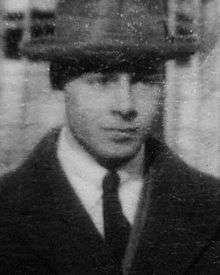Llewellyn Thomas
| Llewellyn Hilleth Thomas | |
|---|---|
 Copenhagen 1926 | |
| Born |
21 October 1903 London, United Kingdom |
| Died |
20 April 1992 (aged 88) Raleigh, North Carolina, USA |
| Thesis | Contributions to the theory of the motion of electrified particles through matter and some effects of that motion (1927) |
| Influences | Wallace John Eckert |
| Notable awards | Smith's Prize (1925) |
Llewellyn Hilleth Thomas (21 October 1903 – 20 April 1992) was a British physicist and applied mathematician.[1] He is best known for his contributions to atomic physics, in particular:
- Thomas precession, a correction to the spin-orbit interaction in quantum mechanics, which takes into account the relativistic time dilation between the electron and the nucleus of an atom.
- The Thomas–Fermi model, a statistical model of the atom subsequently developed by Dirac and Weizsäcker, which later formed the basis of density functional theory.
- Thomas collapse - effect in few-body physics, which corresponds to infinite value of the three body binding energy for zero-range potentials.
His name is frequently attached to an efficient Gaussian elimination method for tridiagonal matrices—the Thomas algorithm.
Born in London, he studied at Cambridge University, receiving his BA, PhD, and MA degrees in 1924, 1927 and 1928 respectively. While on a Traveling Fellowship for the academic year 1925–1926 at Bohr's Institute in Copenhagen, he proposed Thomas precession in 1926, to explain the difference between predictions made by spin-orbit coupling theory and experimental observations.
In 1929 he obtained a job as a professor of physics at the Ohio State University, where he stayed until 1943. He married Naomi Estelle Frech in 1933.[2] In 1935 he was the master's thesis advisor for Leonard Schiff, whose thesis was published with Thomas as coauthor.[3] From 1943 until 1945 Thomas worked on ballistics at the Aberdeen Proving Ground in Maryland. In 1946 he became a member of the staff of the Watson Scientific Computing Laboratory at Columbia University, remaining there until 1968. In 1958 he was elected as a member of the National Academy of Sciences. In 1963, Thomas was appointed as IBM's First Fellow in the Watson Research Center.[4] He was appointed professor at North Carolina State University in 1968, retiring from this position in 1976.[2] In 1982 he received the Davisson-Germer Prize.[5] He died in Raleigh, North Carolina.[2][6]
References
- ↑ Price, Peter J. (September 1994). "Obituary: Llewellyn H. Thomas". Physics Today 47 (9): 115–116. doi:10.1063/1.2808649.
- 1 2 3 Jackson, John David (2009). "Llewellyn Hilleth Thomas 1903 — 1992" (PDF). Biographical Memoirs (Washington, D.C.: National Academy of Sciences).
- ↑ Bloch, Felix (1983), "LEONARD ISAAC SCHIFF", Biographical Memoirs (Washington, D.C.: National Academy Press) 54, pp. 300–323, ISBN 0-309-03391-8
- ↑ http://www.ibm.com/ibm/ideasfromibm/us/ibm_fellows/directory/
- ↑ Llewellyn Thomas, Array of Contermporary American Physicists
- ↑ Jackson, John David (14 Feb 2010). "Llewellyn Hilleth Thomas 1903 – 1992" (PDF).
- Guide to the Llewellyn Hilleth Thomas Papers at the North Carolina State University
- NA-Digest on the attribution of the Thomas Algorithm's name
|